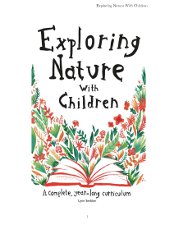Exploring Nature with Children takes a Charlotte Mason approach to nature study, but it offers more depth than most other Charlotte Mason nature study resources. Because of the flexibility built into this study, the whole family can participate together.
Exploring Nature with Children is a sizable, 238-page book with weekly lesson plans arranged to reflect seasonal weather in the northern hemisphere. If you live in a southern hemisphere you can rearrange lessons to some extent, although you would need to do some adaptation for the December lesson since it includes a fourth week on the twelve days of Christmas.
Lesson activities are likely to be most applicable for those living in geographical areas that experience significant differences between the seasons, but they don’t absolutely require large seasonal variations. What is required is access to nature where children can view, handle, and collect items.
Widely divergent topics are covered from seeds and snails to the moon and the winter solstice. For example, September begins with a lesson on seeds, a minibeast hunt, study of the Harvest Moon, and the Autumnal Equinox. In April, lessons shift to a spring tree study, the plant life cycle, wild flowers, and grasses.
Many lessons include nature walks or field trips, but there are some stay-at-home studies, especially for the winter months. (You might use lessons out of order if you need to adjust for the weather.) You should try to find a regular spot for your nature study so that you can observe changes over the course of the year. One or more field guides to local plants, trees, insects, birds, and other wildlife are really essential if you hope to make the most of your nature studies.
Both children and parents should each create their own nature journal where they will draw, label, and record information about their observations. Journal creators are encouraged to add photos, pressed leaves, Scripture verses or other pertinent items as they choose.
Author Lynn Seddon includes detailed correlation in each lesson for those who want to use information, lessons, or activities from the Handbook of Nature Study, although this is optional. Handbook of Nature Study, a book by Anna Botsford Comstock that was published in 1911 (available free at https://archive.org/details/handbookofnature002506mbp), has sections that might be read aloud to children, although the book is written to the teacher. You are most likely to use it as reference material. There are also some useful activities that you might want to take advantage of. Seddon provides the page number for each topic so it's easy to find pertinent pages in Handbook of Nature Study.
Children’s books that tie in with the week’s topic are listed with each lesson, but using these is optional as well.
Seddon includes a poem for each week. Following Charlotte Mason’s recommendations, the poem might be used for read-aloud enjoyment, copywork, or dictation. Similarly, a work of art is listed for each lesson, but you are left to locate each one on the internet or in a book yourself. Picture study questions that you might use are included.
Extension activities might include crafts, drawing, writing, science experiments or investigations, cooking, or listening to “The Four Seasons” by Vivaldi. For example, the extension activities for November’s lesson on Fungi suggest seeing how many different types of fungi children can find, writing in their journal about why fungi are important, drawing and labeling a diagram of a mushroom (with parts to label listed as stem, gills, cap or fruit body, and mycelium), and making a spore print with a freshly picked mushroom (directions are spelled out).
For your nature walks, you will need a magnifying glass and small bags in which to collect nature findings that you are able to take home with you. For other activities, you will need art supplies plus assorted items such as Play Dough, glycerine, a microscope with slides, seeds, bulbs, and items to create a terrarium. These are listed at the front of the book so you can plan ahead.
Exploring Nature with Children offers more-detailed lesson plans than do many other sources for Charlotte Mason style nature walks. In addition, it goes beyond the nature study itself, expanding topics into mini unit studies that connect activities from science, art (appreciation and application), literature, and composition with some fun craft and cooking ideas thrown in. Many activities easily adjust for different age levels, and you can select from among others those most suitable for each child, all of which make it easy to keep the whole family involved.








